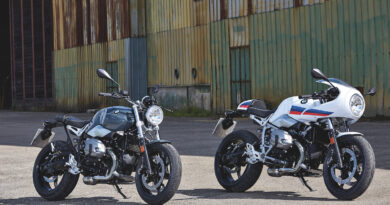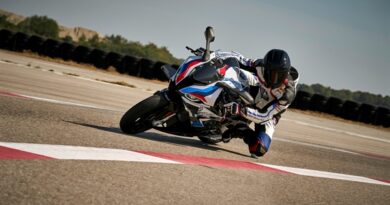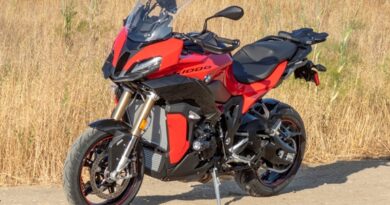F 900 R and XR: A minivan for Millennials is actually a sleeper for Gen X
Photos courtesy of BMW Motorrad and allpar.com
Once upon a time, Dodge released an ugly but incredibly practical passenger vehicle onto an unsuspecting suburban population and ushered in millions of minivan sales. These sensible vehicles were the perfect solution to a utilitarian transportation need. The ubiquitous minivan even became shorthand to represent suburban motherhood. Intrinsically there is nothing wrong with suburbs or motherhood, but the minivan became a pejorative. Although a design triumph of practicality, they became a symbol of staid monotony.
Enter the SUV. Although 99.9% of the miles logged were on pavement and they are more dangerous for children due to rollovers, the SUV offered the illusion of frontier spirit to the denizen of subdivisions. The now-standard issue SUV replaced the minivan, albeit with less comfort and interior space.
With motorbikes, we followed a similar path. Standard motorcycles with road tires and pavement focused suspension and brakes slowly morphed into sportbikes. Although I love sport bikes with almost all my heart, they make terrible street bikes. The dilemma became whether to buy the road version and face the ridicule of “Why didn’t you buy the sport version?” or buy a big, upright lazy bike that looks all butch and tough. Enter the adventure bike. Although objectively ill-suited for road riding, what with the semi-knobby tires, high weight, and compromised handling, they are so comfortable. Rather than looking like a sensible minivan, they speak to aspirational tours to far off places.
So far, so good.
Ten years ago, BMW Motorrad decided to combat their old man reputation by building the fastest sport bike on the planet, opening a new market and customer base to give BMW a performance reputation that slapping some carbon valve covers on a mostly air-cooled twin had, surprisingly, not secured.
However, they released the S 1000 RR right as the sport bike sales wave was crashing against the rocks of the global financial crisis. No doubt, many a meeting room across the motorcycle industry reverberated with confident predictions that sales would recover eventually. Unfortunately, a demographic time bomb had been building for years in the USA. If only we’d been quiet enough to hear them ticking: Automatic transmissions.

Boomers all learned to drive on manual transmissions, and, once your brain has learned about engagement points and gears changes, the transition to a motorbike (coupled with some basic bicycle skills) was easy. Gen Xers, what with our unsupervised bicycle riding of the 70s, and, again, manual transmission starter cars of the 80s, supported the motorcycle boom of the 90s and early 00s. But Millenials, as a rule, learned to drive late and learned to drive solely on automatic transmissions. In fact, my daughter almost failed her driver’s test because the proctor kept insisting she put her car in PARK and the poor girl has no idea how to respond with her five-speed.
Plus, of course, it is impossible to ride a motorcycle without putting down the smartphone.
Put yourself in the shoes of the hapless motorcycle manufactures trying to design a product for a shrinking customer base which, by the market research of the manufactures, are: intimidated by the vehicles, have terrible riding skills sets, no interest in mechanics and, as a rule, don’t want to do anything that requires putting down the phone. #FML.
BMW, following along with Yamaha and others from the past five years, decided the solution to the vanishing motorcycle customer base must be to lower the price of admission, hence, the F 900 R. Only slightly paraphrasing the official press briefing, the design criteria was “It’s gotta sell for under $9,000, look cool in photos, and make the performance as bland as possible so as not to intimidate the customers and include tons of electronic rider aids to reassure our nervous notional customer that it’s safe.”
 The F 900 R checks all the boxes. It’s pretty. It has neat LED lights. It has a pretty instrument cluster. It has phone integration. The seat is narrow and lowish, which gives riders with balky clutch skills a fighting chance of keeping the bike’s ponderous bulk upright in low-speed maneuvers. The press briefing focused on the aspirational market for the bike and, while the photos depicted smiling connected social mobile local millennials (female!), straddling bikes while wearing sneakers (no ATGATT, brah?), the expected average age of folks actually buying the bike is …um… 43. So, skinny jeans for Gen X?
The F 900 R checks all the boxes. It’s pretty. It has neat LED lights. It has a pretty instrument cluster. It has phone integration. The seat is narrow and lowish, which gives riders with balky clutch skills a fighting chance of keeping the bike’s ponderous bulk upright in low-speed maneuvers. The press briefing focused on the aspirational market for the bike and, while the photos depicted smiling connected social mobile local millennials (female!), straddling bikes while wearing sneakers (no ATGATT, brah?), the expected average age of folks actually buying the bike is …um… 43. So, skinny jeans for Gen X?
BMW determined most people buy the F model on appearance alone, and, to their credit, the bike looks great both in pictures and IRL. They are releasing both Berlin-built models (R and XR) in a wide variety of colors with the possibility of matching luggage and accessories. In fact, there is a dizzying array of upsell features available like quick shifters, lever guards and dynamic suspension. There is also a complex array of ride modes, anti-lock brake, anti-wheelie control and traction control settings.
In fact, the press briefing focused so much on the lights, the style and the electronic settings that they barely mentioned the engine, suspension or frame. Most of all, they didn’t mention the weight.
The F 900 R, replete with steel frame, weighs 465 pounds; the XR version tips the scales at 483. The Yamaha MT-09, the bike BMW identified as a direct competitor for the F 900, weighs in 424 pounds and, being a triple, has 115 horsepower to the BMW twin’s 99. Tough competition indeed.
 Which brings us to the differences between the R and the XR. The R is the naked bike, which starts at $8,995. The XR has higher bars, slightly longer travel suspension, a bikini fairing and starts at $11,695. Checking a couple boxes on the order form can add $2,850 to the purchase price to add heated grips, GPS prep, saddlebag mounts, tire pressure monitoring, cruise control, keyless ride, gear shift assist pro, ride modes pro, anti-theft alarm, dynamic rear shock and fancier headlights that illuminate more in turns. There is also a factory lowering kit, a variety of seats to change the seat height, and both hard and soft bags.
Which brings us to the differences between the R and the XR. The R is the naked bike, which starts at $8,995. The XR has higher bars, slightly longer travel suspension, a bikini fairing and starts at $11,695. Checking a couple boxes on the order form can add $2,850 to the purchase price to add heated grips, GPS prep, saddlebag mounts, tire pressure monitoring, cruise control, keyless ride, gear shift assist pro, ride modes pro, anti-theft alarm, dynamic rear shock and fancier headlights that illuminate more in turns. There is also a factory lowering kit, a variety of seats to change the seat height, and both hard and soft bags.
Quite frankly, after the press briefing, I was prepared to hate the bike. Both are good looking motorbikes, designed to be ridden on the street without dirt pretensions. They also don’t have linkage rear suspension (costs more), have non-adjustable forks (costs more), have steel frames (what year is this?), and cheap chain adjusters, levers and master cylinders. Anywhere on the bike non-mechanical people wouldn’t notice is where BMW shaved costs. BMW put the money into the lights and the instrument panel. Although I love super bright headlights, I also appreciate a good swingarm.
 My recreational street riding is bimodal. Most of it takes place on the delightfully curvy roads in the mountains of West Virginia, and my riding companions are divided between the Raid group (ex and current road racers, all experts, a spirited pace where the tires blue overnight) and the Princess Sparkle Pony Ride (PSPR) group consisting of my daughter and three other millennial females, plus some of the experts riding their vintage bikes or other slow stuff. I tried to put myself in the mindset of the latter group, but the ride leader in California was very much thinking the former.
My recreational street riding is bimodal. Most of it takes place on the delightfully curvy roads in the mountains of West Virginia, and my riding companions are divided between the Raid group (ex and current road racers, all experts, a spirited pace where the tires blue overnight) and the Princess Sparkle Pony Ride (PSPR) group consisting of my daughter and three other millennial females, plus some of the experts riding their vintage bikes or other slow stuff. I tried to put myself in the mindset of the latter group, but the ride leader in California was very much thinking the former.
I rode the XR for the morning and the R in the afternoon. The first thing I did was get into the settings and turn off the ABS, wheelie control and traction control. The XR ships with Michelin’s superb Road 5 tires. I have a fair number of hours on this rubber and know for a fact the rear tire will wheelie, not spin, in the rain. That 180 tire was not in any danger of lighting up from the F 900’s meager power output.
Our morning route was a mix of California suburb and canyon scratching. I thought the low seat would squish my 5’ 10” frame to the footpegs, I thought the bucketed seat would get uncomfortable and the budget suspension would annoy me, but I thought wrong. The first part of our ride was at Princess Sparkle Pony pace and the XR’s lazy engine, upright seating position and even the easy flip-up adjustable windshield were all very civilized. I could easily see the bike being a friendly, low-intimidation all-day bike for leading a PSPR. Yeah, the seat was a little low, but they have taller ones available from the factory.
 Once we got to the canyons, my riding colleague’s enthusiasm required me to up my game. The XR has more of a rear-wheel weight bias, and the high bars make it difficult to load the front tire with body weight, but for an upright bike, it could hustle. The chassis, relaying feedback through overly stiff springs (for my 175 pounds), felt dead, but the Michelins only ever moved when crossing gravel. If I’m riding fast, I like a lot of feedback from the chassis; however, all that feedback is tiring and distracting when I’m not trying to ride fast. BMW engineered it to be less tiring over a day of riding, which means less chit-chat from the bike.
Once we got to the canyons, my riding colleague’s enthusiasm required me to up my game. The XR has more of a rear-wheel weight bias, and the high bars make it difficult to load the front tire with body weight, but for an upright bike, it could hustle. The chassis, relaying feedback through overly stiff springs (for my 175 pounds), felt dead, but the Michelins only ever moved when crossing gravel. If I’m riding fast, I like a lot of feedback from the chassis; however, all that feedback is tiring and distracting when I’m not trying to ride fast. BMW engineered it to be less tiring over a day of riding, which means less chit-chat from the bike.
Initially, I didn’t like the front brake, as I was trail braking into turns to try to keep the long-travel suspension compressed. The brakes lacked bite at the first 5% of lever travel, but as the ride worn on, I realized it was just that the bike I was riding only had eight miles on it and the pads had not yet bedded into the rotors. Once broken in, the brakes worked well for the rhythm of the roads.
The XR hides its weight well. We were rolling hard on paved single lane roads at a pace more appropriate for Raid than PSPR, cleaning the rear tires and using full throttle off the apexes to try to make incrementally tiny bits of time on the parsimonious straights (50 feet?) between blind second gear turns with no centerlines on the pavement. The fueling on the F 900 is linear without the snatchiness one expects from the ultra-lean mixtures required to satisfy the EPA. The XR even responded well to mid-corner corrections required by the odd erratic boulder or washed-out section of road. Sure, the suspension wasn’t ideal, but that was at a pace that, honestly, most of the target market for this bike would never attain. At cruising speeds, the parallel twin, with its dual counterbalancers, is smooth, smoother than many fours. The footpegs were absolutely placid and the bars only had a tiny bit of buzz in them.
 The transmission is robust. Passing on the highway at upwards of 100 mph required more of a middleweight tactic: Drop two gears, pin the throttle and speed shift as the RPM approached redline. My bike didn’t have the quick shifter, but PRO TIP: You can speed shift most modern bikes! The highway passing was one of the things that would put this bike firmly in the PSPR camp. It is perfectly happy rolling along at a brisk pace on its own, but it needs some runway to get around traffic on back roads.
The transmission is robust. Passing on the highway at upwards of 100 mph required more of a middleweight tactic: Drop two gears, pin the throttle and speed shift as the RPM approached redline. My bike didn’t have the quick shifter, but PRO TIP: You can speed shift most modern bikes! The highway passing was one of the things that would put this bike firmly in the PSPR camp. It is perfectly happy rolling along at a brisk pace on its own, but it needs some runway to get around traffic on back roads.
The seating position is so comfortable! The high bars make it easy to ride standing up, either over rough pavement or just to stretch the legs.
After lunch, I switched to one of the R models. The XR is definitely more of the old man bike compared to the R. The R has lower bars (but by no means low), Bridgestone S21 R tires (another very good tire), slightly less travel (but the springs on both bikes are so stiff it ain’t like I was getting through the suspension on either one) and no fairing.
As expected, the R felt a little sassier in all regards and was a little more inspiring for hooligan antics. There were only about 60 seconds to familiarize myself with the bike from throwing my leg over it for the first time to where Kevin Wing was shooting photos in the vineyard, but I was able to clutch up a mono for him.
 The R was definitely more of the rider’s bike. The lighter weight and lower riding position made it was easier to scratch on the canyon roads, but it is still far from anything like sport bike ergonomics. Trying to keep a pace on the bike meant riding like a lightweight: Keep the engine spun up, keep the momentum through the turn and get the throttle wide open every chance you get.
The R was definitely more of the rider’s bike. The lighter weight and lower riding position made it was easier to scratch on the canyon roads, but it is still far from anything like sport bike ergonomics. Trying to keep a pace on the bike meant riding like a lightweight: Keep the engine spun up, keep the momentum through the turn and get the throttle wide open every chance you get.
The R has about 3% more weight on the front wheel; coupled with the lower bars, it was a bit easier to get the front tire loaded in the hard canyon carving. Sure, the lack of the XR fairing means a bit more cool mountain air into the front of my vented leathers, but the bike isn’t really fast enough to generate that much wind blast. What wind lift there balanced nicely with the bar height. The $2,700 price difference between the R and the XR easily pays for an electric vest and a nice multi-season riding suit.
Our afternoon route took us over some rough, decaying pavement, including potholes, gravel and broken pavement. The budget suspension was a bit stiff for such shocks, but it was easy enough to just stand on the pegs and ride it like an enduro.
Watching the sun set over the Pacific, I reflected on the last 250 miles of aggressive riding. For comfort on a PSPR, I’d grab the XR, but for all other riding, it would be the R all the way. As far as BMW’s aspiration for this bike to be the sensible minivan for my millennial female riding friends’ second bike, I don’t think that’s going to work out. Too heavy. For the Gen Xers looking for an entry into a great brand at a bargain-basement price, though – oh yeah, these work.
About the author: Sam Fleming has logged 300,000 street miles on various BMWs, captained the national endurance team Army of Darkness to 13 national championships (five on BMWs) and mentors a group of Princess Sparkle Pony street, track day and dirt riders.



